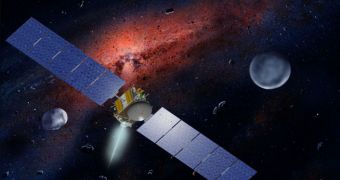Scientists with the NASA Jet Propulsion Laboratory (JPL) in Pasadena, California, announce that the Dawn space probe has been reawaken again, after six months of hibernation. The reason for this is that the spacecraft is approaching its first target, Vesta, the largest known asteroid in the solar system.
The explorer is currently near the inner asteroid belt, between the orbits of Mars and Jupiter. It is first heading towards Vesta, but it will then leave its orbit to study the dwarf planet Ceres, located nearby.
Starting this May, Dawn will begin its final approach to the massive asteroid, in whose orbit it must enter in July 2011. Ahead of these milestone maneuvers, the machine was commanded to reawaken some of its scientific instruments.
These included the framing cameras (that analyze star locations to determine the probe's position), the visible-light and infrared mapping spectrometers (which detects surface mineralogy) and the gamma ray and neutron detectors, which Dawn uses to establish its targets' elemental composition.
“Last week, we gently 'woke up' Dawn's three science instruments, which typically spend most of their time sleeping during the three-and-a-half-year journey to Vesta,” explains expert Robert Mase.
“This activity confirms that Dawn is on track for the first close examination of one of the last unexplored worlds of the inner solar system,” adds the official, who is the JPL Dawn project manager.
“The camera system is working flawlessly. The dry run was a complete success,” says the lead investigator for the framing camera, Andreas Nathues.
He is based at the Max Planck Institute for Solar System Research in Katlenburg-Lindau, Germany, which manages this instrument's activities. The announcement was made after three days of continuous interactions with the camera.
One new software was also uploaded to the spacecraft, fixing whatever bugs and glitches experts discovered during previous checkups. Dawn needs to be in tip-top shape when the time to study Vesta comes, in just 4 months.
The framing cameras will play a critical role in those investigations, as they will need to determine whether any volcanic activity took place on the asteroid in the recent past. They will also need to search for any moons that may exist around the giant space rock.
Vesta has a diameter of about 530 kilometers, and is widely considered to be an early protoplanet with a differentiated core. Scientists say it makes up about 9 percent of the inner asteroid belt, and that it's the second-largest object in it, after Ceres.

 14 DAY TRIAL //
14 DAY TRIAL //